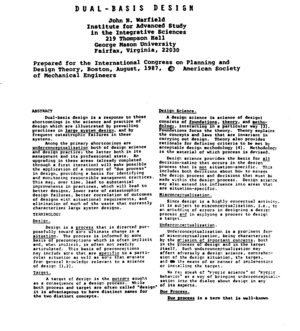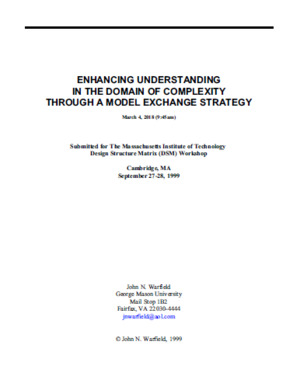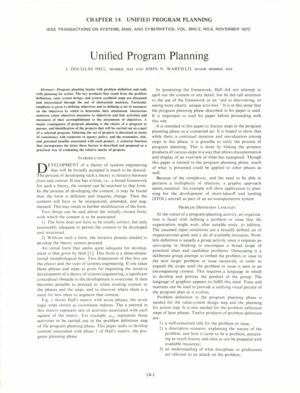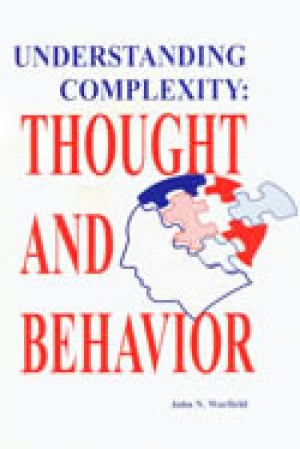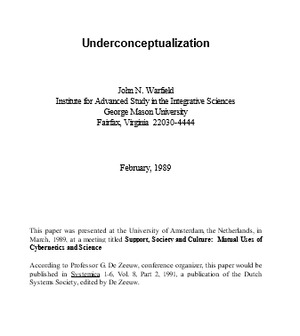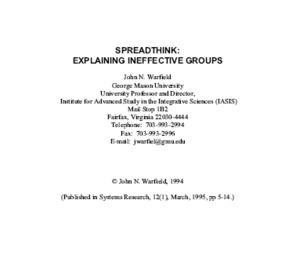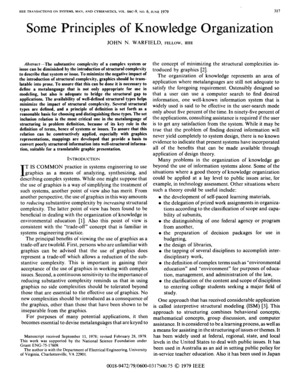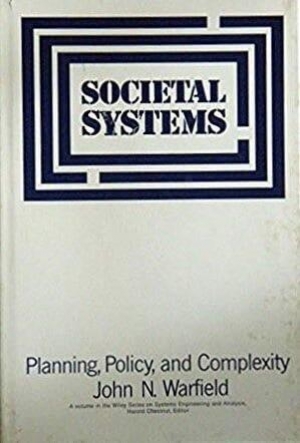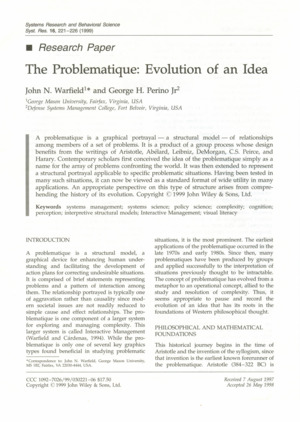Tom Warfield
Dual-Basis Design
Discussion of the concept of due process in design as a way to identify and monitor responsible management practices, which would lower the rate of catastrophic design failures. Warfield calls for the creation of a basic design science, with standards and practices for large-scale system designers that could become well-defined and legally enforceable over time. Prepared for ASME Conference, Boston, MA, 17-20 August 1987. See, "Dual-Basis Design (Transparencies)" for the transparencies developed to accompany talk. Later printed in Polish. See, "Dwie Podstawy Projektowania (Dual-Basis Design)."
Enhancing Understanding In The Domain Of Complexity Through A Model Exchange Strategy
Discussion of a model exchange strategy in the domain of complexity. The abstract states that the “overall effectiveness must take into account factors that are not well-treated exclusively by matrix models. Some of the other types that (also) have limited, but valuable, utility include: algebraic models, prose models, various ill-defined graphical models (often understood only by very small practitioner sets), and prose-graphic structural models.” Originally presented 28 September 1999 at the MIT Design Structure Matrix (DSM) Workshop, Presentation, Sloan School, Cambridge, MA. See also,"MIT Design Structure Matrix Workshop Program"
Unified Program Planning
This paper illustrates how self-interaction and cross interaction matrices can be used to portray interactions among several sets that can be important in program planning. It is a precursor to the development of interpretive structural modeling, in that the unwieldiness of the matrices, the need for directionality in relations, the need for computer assistance in keeping track of the information, and the need for a more easily read graphical portrayal all became apparent in working with the various planning matrices.
Understanding Complexity: Thought and Behavior
This book explains a new science Warfield developed between 1970 and 2000. His Interactive Management system is the action branch of systems science, which springs from the foundations of a scientific theory outlined in this book.
The book began as a set of lectures, classroom handouts, seminars and small monographs organized in 1995 into a manuscript titled “Work Program of Complexity.”
In 1998, after an extensive revision with much new material added, Warfield changed the title to “A Structure Based Science of Complexity.” After a few more modifications until June 2001 he finalized the title as Understanding Complexity: Thought and Behavior.
Underconceptualization
This paper addresses a need for change in how people work with complexity. The needed change is described as "Framebreaking and Remodeling." The term "Underconceptualization" is used to capture the essence of what is wrong in design, development and operation of large-scale systems. Presented at Conference on Mutual Uses of Cybernetics & Science, University of Amsterdam, 27-31 March 1989. This conference paper submitted in 1989 is free of typo errors seen in 1991 published article.
Spreadthink: Explaining Ineffective Groups
Warfield’s data on individual reactions to group problems has revealed a phenomenon he calls Spreadthink, e.g, there exists a consistent lack of commonality of viewpoint, no matter what the group, no matter what the problem. The disparity in attitudes among individuals is so great as to produce ineffective group decision making unless further education and understanding takes place between group members. Presented at 16th Annual Meeting, Assn. for Integrative Studies, Duquesne University, Pittsburgh, PA, 30 September 1994.
Some Principles of Knowledge Organization
Contains part of the theory needed for writing Interpretive Structural Modeling software. The mathematical theory of how to eliminate overlap among concepts, using Translatable Graphics, Structural Types, Problem Definitions, Block Representation of Sets, and Mapping Theory, can be helpful in replacing a set of overlapping goals with a set of relatively independent goals when constructing a usable planning or policy decision.
Societal Systems: Planning, Policy and Complexity
Societal Systems describes a unique methodology for coping with complexity - Interpretive Structural Modeling.
ISM, with its efficient and rapid organization of knowledge, can become the basis for modeling dramatic social or organizational gains.
The book contains the theoretical and mathematical background for the ISM process, which remains in use as a major source for persons wishing to develop software for Interpretive Structural Modeling. A modern version of ISM software is available on this site.
Ajar Publishing is working on a corrected reprint of Societal Systems that may be available in 2019.
Readings for Bureaucrats
This is a bibliography, a short, fully annotated list of works by 33 authors whose writings contribute to essential knowledge needed to understand and take advantage of the Warfield program for dealing with complexity. This paper was used as a handout to accompany a talk Warfield gave to the AAAS Fellows meeting (American Association for the Advancement of Science) in Washington, D.C. on 13 May 1997.
The Problematique: Evolution of an Idea (1999)
This is a greatly reduced and greatly altered version of a paper by the same title which John Warfield wrote in 1996 and submitted to Systems Research in 1997. It is a review of the intellectual history presaging the development of the Interactive Management (IM) adaptation and use of structural graphics to display results of IM Workshops.

